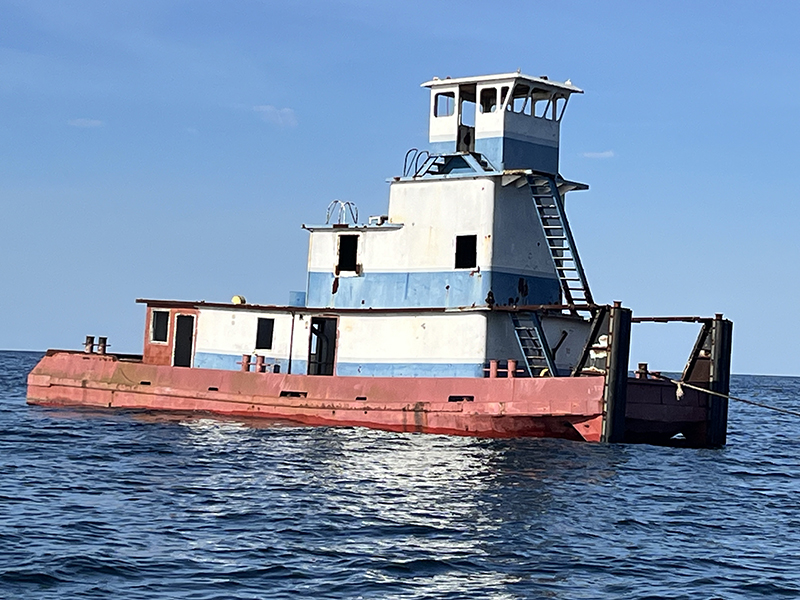Advertisement
Georgia Completes Three Significant Offshore Artificial Reef Deployments
CRD Press Release | June 12, 2024

The Sarah Katlin before sinking on May 31, 2024. DNR photo by Brian Cedars.
The Coastal Resources Division (CRD) of the Georgia Department of Natural Resources recently completed three significant additions to Georgia’s offshore artificial reefs. CRD’s Habitat Enhancement and Restoration Unit conducted these deployments to enhance marine habitats and support local biodiversity. All materials were thoroughly cleaned and inspected by the U.S. Coast Guard prior to deployment.
On May 31, the 62-foot tug Sarah Katlin was deployed to Reef JY, situated 17 nautical miles east of St. Catherines Island. This deployment aims to create new habitats for marine life and support the local fishing community. The vessel sank in 68 feet of water at 31.60667°N, 80.79922°W (31°36.400’N, 80°47.953’W).
Following this, on June 5, approximately 63 tons of concrete blocks previously used by the U.S. Coast Guard to anchor aids to navigation were added to Reef SAV about 6 nautical miles east of Tybee Island. These materials provide essential structure for various marine species, promoting ecological diversity and sustainability. The blocks were placed by the U.S. Coast Guard Cutter Willow (WLB-202), a seagoing buoy tender, in 41 feet of water at 31.92138°N, 80.78621°W (31°55.283’N, 80°47.173’W).

Coast Guard Cutter Willow. DNR photo by Cameron Brinton.
The final deployment occurred June 6, when the 50-foot tug G.A. Franklin was added to Reef HLHA, 23 miles east of Little Cumberland Island. This addition further expands the available habitats for fish and other marine organisms, contributing to the overall health of Georgia’s coastal ecosystems. The Franklin went down in 76 feet of water at 30.98958°N, 80.95315°W (30°59.375’N, 80°57.189’W).

G.A. Franklin sinking. DNR photo by Tyler Jones.
The Savannah ABC affiliate WJCL-TV joined CRD for the deployment of the G.A. Franklin. The station aired an informative story highlighting the meticulous process of cleaning and preparing reef materials for deployment, ensuring environmental safety and effectiveness.
“We are very happy with the success of these reef deployments,” said Paul Medders, CRD’s Habitat Enhancement and Restoration Unit lead. “Artificial reefs play a crucial role in enhancing marine habitats, supporting fish populations, and boosting recreational fishing opportunities. These additions will provide long-term benefits for our coastal environment and community. While the reef materials are man-made, the organisms that will find a home here are totally natural.”
The Coastal Conservation Association Georgia, a CRD partner, provided financial support to make the reef deployments possible. Members of the public can also show their support for artificial reef creation by purchasing the “Support Fish Habitat” license plate (Code “NR”) at their local tag office. This eye-catching tag features the state saltwater fish, the red drum, and costs just $25 more annually than a standard tag.
The CRD remains committed to conserving and enhancing Georgia’s coastal resources for present and future generations. For more information about the artificial reef program and other conservation initiatives, please visit CoastalGaDNR.org/HERU.
About the Coastal Resources Division
The mission of the Coastal Resources Division is to balance coastal development and protection of the coast’s natural assets, socio-cultural heritage and recreational resources for the benefit of present and future generations.
Georgia Saltwater Fishing Page
Advertisement
Other Articles You Might Enjoy
Advertisement









